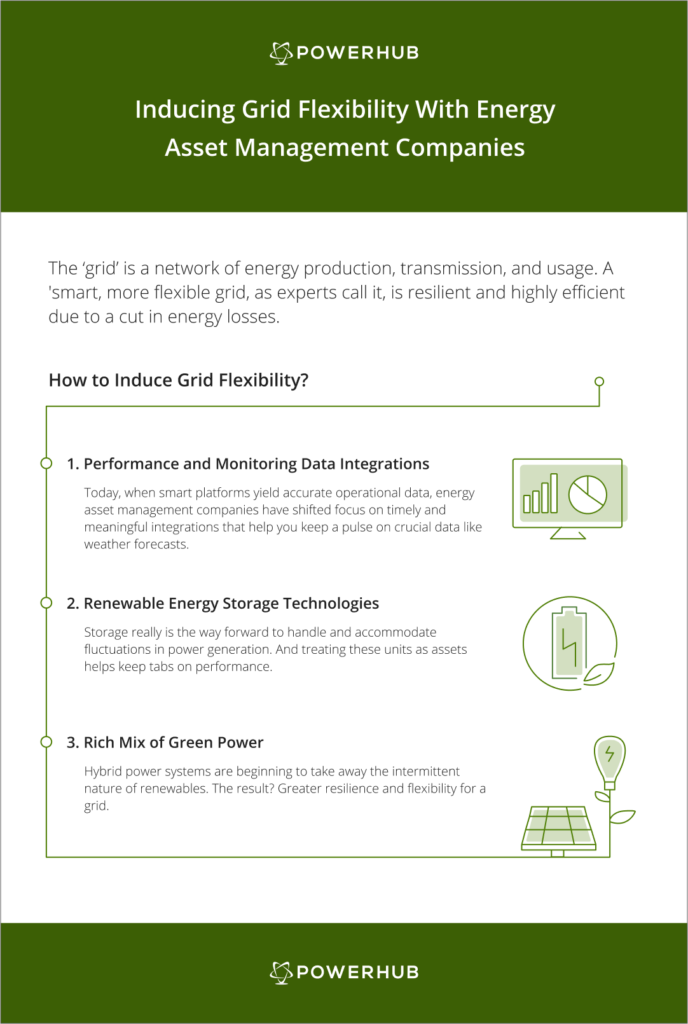Have you heard of Project Drawdown? That’s what comes to mind when we think of grid flexibility, and the role of energy asset management companies in this mission to save our planet.
A much-needed initiative, the project talks about the contributions of various sectors towards climate change. Quite literally, it defines ‘drawdown’ as a point in the future when levels of greenhouse gases see a steady decline.
On a list of 100 possible solutions to our climate worries, Project Drawdown ranks grid flexibility 77th. So yes, it’s important. But what is it, really?
What’s Grid Flexibility?
The ‘grid’ is a network of energy production, transmission, and usage. Traditionally, it’s been designed for the constant generation and distribution of power. So, it’s safe to say that the intermittent nature of renewable energy project planning sort of puts it out of balance (hang on, there’s good news coming…).
Hence, if we’re to rally for majority renewables in the next 20-30 years, clean energy must induce flexibility in the grid. It must adapt to various sources of power production and should be resilient enough to withstand minor disruptions.
How Do Energy Asset Management Companies Induce Grid Flexibility?
This is where expertise from energy asset management companies comes in. It wouldn’t be incorrect to say that making the grid flexible, and consequently generating a larger chunk of global power with renewables, demands innovation and investment.
Therefore, making the right investments helps tackle power production problems in traditional grid networks.

Performance & Monitoring Data Integrations
Some ten years back, being able to gather monitoring and performance data was the biggest concern energy asset management companies had. Today, when smart platforms have accomplished that, the focus has shifted toward timely, and meaningful integrations.
Inducing flexibility in a grid means having a pulse on crucial data like weather forecasts and performance trends. Doing so helps zero-in on recurring problems. Were those dips in power generation due to the weather – provided they occurred at the same time across four regions?
Such analysis is the basis of a modern renewable energy grid that can withstand fluctuations and slight irregularities.
Renewable Energy Storage Technologies
The most important part of the grid flexibility equation is storage. We’ve previously talked about storage being one of the Top 5 renewable energy trends for the next decade.
It really is the way forward to handle and accommodate fluctuations in power generation. When there’s adequate storage to work around problems like the mighty duck curve in California, a grid will have the much-needed flexibility to manage peak and troughs in demand.
With advances in clean tech, there are a number of storage solutions being tested today. Liquid air storage, for one, has gained immense traction in the United Kingdom.
Smart energy asset management companies understand the benefits of treating storage technologies as independent assets. It helps track their performance, flagging problem areas when planning grid flexibility for the future.
Rich Mix of Green Power
Using a rich mix of green power can really help minimize the intermittent nature of renewables. Also known as Hybrid Power Systems, such a setup takes advantage of solar panels, as well as wind turbines on the same piece of land.
So, when the sun isn’t shining, wind can take over – and vise versa. The result? Greater resilience and flexibility for a grid. When a network relies on various sources of power, all of which complement each other, volatility reduces manifolds.
No doubt, with a rich mix of renewables comes complexity. And this translates into a greater need for energy asset management companies to streamline processes and spike the value of these assets.
Does Grid Flexibility Help Achieve Majority Renewables?
With these benefits at the forefront, it becomes easier to imagine better interconnections and stability between neighboring grids worldwide.
Project Drawdown calls transmission and distribution lines the ‘connective tissue between generation and consumption’. Thus, energy asset management companies induce resilience, automation, and strength in renewable energy assets. All the while keeping these connective tissues healthy and pulsing.




